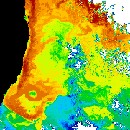
Topic Area
East Australian Current and Eddies
Project Team Member(s)
LT Richard Kennedy, USN
Major Findings
The East Australian Current (EAC) is the western boundary of the South Pacific sub-tropical gyre. It flows south along Australia’s east coast and brings warm waters to the northern and western coasts of New Zealand. As it flows to the east it maintains a boundary between the warm Coral Sea waters and the cooler waters of the Tasman Sea, also known as the Tasman Front. Although it is the weakest of all western boundary currents with a maximum of 15 Sv, it is associated with very strong instabilities. The instabilities are an effect of the current leaving the Australian coast near 34° S to continue along the eastern coast of New Zealand. Several times a year the current will extend as far south as 42° S where it will make a U-turn back to the north and continue its flow eastward toward New Zealand. This "retroflection" can be pinched by baroclinic Rossby waves traveling along the Tasman Front spawning eddies that greatly influence the waters south of the EAC
Because the meander of the EAC remains close to the coast it only traps warm water from the Coral Sea, creating warm-core, anti-cyclonic eddies. Eddies are generated 2-3 times a year and have a lifespan of at least 18 months. Between 4-8 eddies may co-exist at any particular time. They can be as broad as 250 km, extending to depths of 500m. Their max edge speeds are 4 knots. They do not rotate as solid bodies: at the edge a complete rotation may take 5 days; in the nearer center a rotation is 2 days. The flow conserves angular momentum producing changes is speeds when eddies become elliptical due to collisions with the continental shelf.
The five major causes of eddy decay are:
•Natural decay through cooling and mixing ~ 2-3 yrs
coalescence of the eddy.
•Collision with the shelf causing distortion and possible collapse of the eddy.
•Pairing up with another eddy.

References
Brink, K.H., and Robinson, A.R., Australia's Shelf Seas: Diversity
and Complexity , The Sea, Volume 11, 933-965, 1998.
Cresswell, G.R., and R. Legeckis, 1986: Eddies off southeastern Australia. Deep-Sea Res., 33, 1527-1562.
Nilsson, C.S., and G.R. Cresswell, 1981: The formation and evolution
of East Australia Current warm-core eddies. Prog. Oceanog., 9, 133-183.
| This is a government-maintained internet site. Please read the U.S. Navy web page disclaimer and the disclaimer regarding external links. |